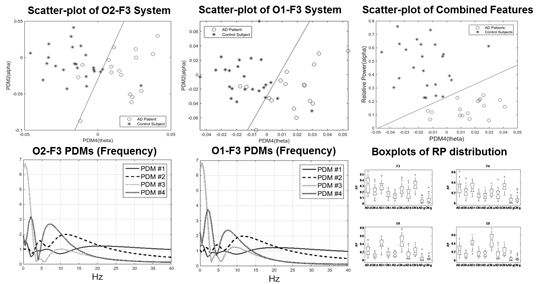
We examine whether modeling of the causal dynamic relationships between frontal and occipital electroencephalogram (EEG) time-series recordings reveal reliable differentiating characteristics of Alzheimer’s patients versus control subjects in a manner that may assist clinical diagnosis of Alzheimer’s disease (AD). The proposed modeling approach utilizes the concept of Principal Dynamic Modes (PDM) and their associated nonlinear functions (ANF) and hypothesizes that the ANFs of some PDMs for the AD patients will be distinct from their counterparts in control subjects. To this purpose, “global” PDMs are extracted from 1-min EEG signals of 17 AD patients and 24 control subjects at rest using Volterra models estimated via Laguerre expansions, whereby the O1 or O2 recording is viewed as the “input” signal and the F3 or F4 recording as the “output” signal. Subsequent singular value decomposition (SVD) of the estimated Volterra kernels yields the global PDMs that represent an efficient basis of functions for the representation of the EEG dynamics in all subjects. The respective ANFs are computed for each subject and characterize the specific dynamics of each subject. For comparison, signal features traditionally used in the analysis of EEG signals in AD are computed as benchmark. The results indicate that the ANFs of two specific PDMs, corresponding to the delta-theta and alpha bands, can delineate the two groups well.
View full article

